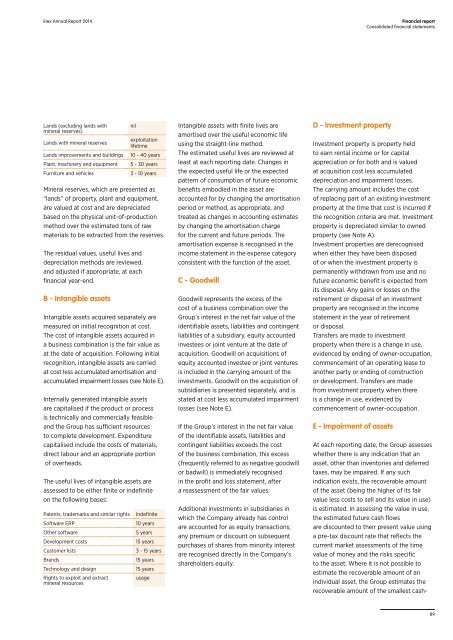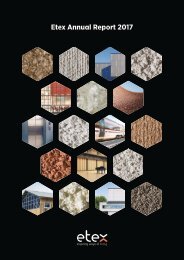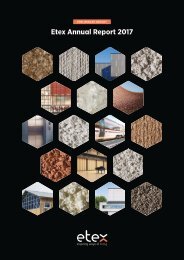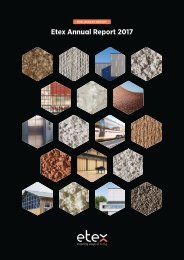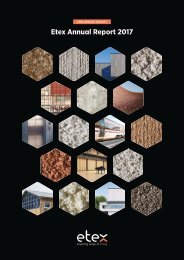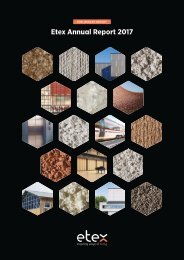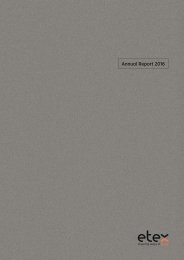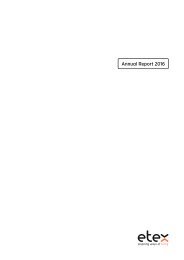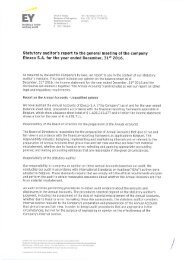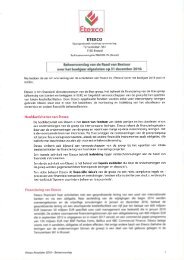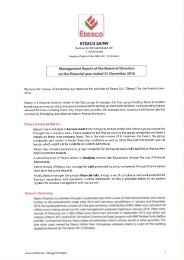Annual Report 2014
This is the 2014 annual report of Etex Group
This is the 2014 annual report of Etex Group
You also want an ePaper? Increase the reach of your titles
YUMPU automatically turns print PDFs into web optimized ePapers that Google loves.
Etex <strong>Annual</strong> <strong>Report</strong> <strong>2014</strong><br />
Financial report<br />
Consolidated financial statements<br />
Lands (excluding lands with<br />
mineral reserves)<br />
Lands with mineral reserves<br />
Lands improvements and buildings<br />
Plant, machinery and equipment<br />
Furniture and vehicles<br />
nil<br />
exploitation<br />
lifetime<br />
10 - 40 years<br />
5 - 30 years<br />
3 - 10 years<br />
Mineral reserves, which are presented as<br />
“lands” of property, plant and equipment,<br />
are valued at cost and are depreciated<br />
based on the physical unit-of-production<br />
method over the estimated tons of raw<br />
materials to be extracted from the reserves.<br />
The residual values, useful lives and<br />
depreciation methods are reviewed,<br />
and adjusted if appropriate, at each<br />
financial year-end.<br />
B - Intangible assets<br />
Intangible assets acquired separately are<br />
measured on initial recognition at cost.<br />
The cost of intangible assets acquired in<br />
a business combination is the fair value as<br />
at the date of acquisition. Following initial<br />
recognition, intangible assets are carried<br />
at cost less accumulated amortisation and<br />
accumulated impairment losses (see Note E).<br />
Internally generated intangible assets<br />
are capitalised if the product or process<br />
is technically and commercially feasible<br />
and the Group has sufficient resources<br />
to complete development. Expenditure<br />
capitalised include the costs of materials,<br />
direct labour and an appropriate portion<br />
of overheads.<br />
The useful lives of intangible assets are<br />
assessed to be either finite or indefinite<br />
on the following bases:<br />
Patents, trademarks and similar rights<br />
Software ERP<br />
Other software<br />
Development costs<br />
Customer lists<br />
Brands<br />
Technology and design<br />
Rights to exploit and extract<br />
mineral resources<br />
Indefinite<br />
10 years<br />
5 years<br />
15 years<br />
3 - 15 years<br />
15 years<br />
15 years<br />
usage<br />
Intangible assets with finite lives are<br />
amortised over the useful economic life<br />
using the straight-line method.<br />
The estimated useful lives are reviewed at<br />
least at each reporting date. Changes in<br />
the expected useful life or the expected<br />
pattern of consumption of future economic<br />
benefits embodied in the asset are<br />
accounted for by changing the amortisation<br />
period or method, as appropriate, and<br />
treated as changes in accounting estimates<br />
by changing the amortisation charge<br />
for the current and future periods. The<br />
amortisation expense is recognised in the<br />
income statement in the expense category<br />
consistent with the function of the asset.<br />
C - Goodwill<br />
Goodwill represents the excess of the<br />
cost of a business combination over the<br />
Group’s interest in the net fair value of the<br />
identifiable assets, liabilities and contingent<br />
liabilities of a subsidiary, equity accounted<br />
investees or joint venture at the date of<br />
acquisition. Goodwill on acquisitions of<br />
equity accounted investee or joint ventures<br />
is included in the carrying amount of the<br />
investments. Goodwill on the acquisition of<br />
subsidiaries is presented separately, and is<br />
stated at cost less accumulated impairment<br />
losses (see Note E).<br />
If the Group’s interest in the net fair value<br />
of the identifiable assets, liabilities and<br />
contingent liabilities exceeds the cost<br />
of the business combination, this excess<br />
(frequently referred to as negative goodwill<br />
or badwill) is immediately recognised<br />
in the profit and loss statement, after<br />
a reassessment of the fair values.<br />
Additional investments in subsidiaries in<br />
which the Company already has control<br />
are accounted for as equity transactions;<br />
any premium or discount on subsequent<br />
purchases of shares from minority interest<br />
are recognised directly in the Company’s<br />
shareholders equity.<br />
D - Investment property<br />
Investment property is property held<br />
to earn rental income or for capital<br />
appreciation or for both and is valued<br />
at acquisition cost less accumulated<br />
depreciation and impairment losses.<br />
The carrying amount includes the cost<br />
of replacing part of an existing investment<br />
property at the time that cost is incurred if<br />
the recognition criteria are met. Investment<br />
property is depreciated similar to owned<br />
property (see Note A).<br />
Investment properties are derecognised<br />
when either they have been disposed<br />
of or when the investment property is<br />
permanently withdrawn from use and no<br />
future economic benefit is expected from<br />
its disposal. Any gains or losses on the<br />
retirement or disposal of an investment<br />
property are recognised in the income<br />
statement in the year of retirement<br />
or disposal.<br />
Transfers are made to investment<br />
property when there is a change in use,<br />
evidenced by ending of owner-occupation,<br />
commencement of an operating lease to<br />
another party or ending of construction<br />
or development. Transfers are made<br />
from investment property when there<br />
is a change in use, evidenced by<br />
commencement of owner-occupation.<br />
E - Impairment of assets<br />
At each reporting date, the Group assesses<br />
whether there is any indication that an<br />
asset, other than inventories and deferred<br />
taxes, may be impaired. If any such<br />
indication exists, the recoverable amount<br />
of the asset (being the higher of its fair<br />
value less costs to sell and its value in use)<br />
is estimated. In assessing the value in use,<br />
the estimated future cash flows<br />
are discounted to their present value using<br />
a pre-tax discount rate that reflects the<br />
current market assessments of the time<br />
value of money and the risks specific<br />
to the asset. Where it is not possible to<br />
estimate the recoverable amount of an<br />
individual asset, the Group estimates the<br />
recoverable amount of the smallest cash-<br />
89


